Carl Whitcomb — June 1, 2013
Understanding a key law of soil physics is critical to providing optimal irrigation for improved plant growth.
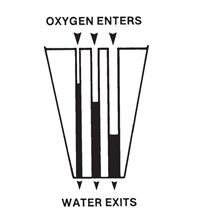
Click image to enlarge.
Figure 1. Every container retains considerable water at the bottom of the growth medium. If the pore spaces are small, a great deal of water is retained. If the pore spaces are large, less water is retained. Water stops draining from a container when the weight of the water at the top of the column is no longer sufficient to overcome capillarity attraction between water and mix particles and attraction of water to water to force water out the drain holes.
Everywhere you turn, there seem to be more and more laws. But knowledge of some laws can be beneficial and even useful. When planting plants grown in containers in the landscape or field, Darcy’s law of soil physics directly applies. Darcy’s Law summarized: Water moves readily from a coarse-textured material to a finer texture. Water will not move from a fine texture to a coarse texture until saturation.
Because of the unique environment of a container, in order to have sufficient drainage and oxygen for root functions, a mix more coarse in texture than any field soils is required. In a container, the mix or growth medium holds considerable water including a zone in the bottom that is often at or near the saturation point (Figure 1). However, once removed from the container and installed in field soil, the growth medium abruptly goes from holding too much water to holding very little. The reason for this abrupt change is Darcy’s Law.
Practical applications
- Do not place rock, gravel, or other coarse material in the bottom of a planting hole. Coarse material will cause water to accumulate above the coarse material.
- If drainage tile must be used, place the drain line 12 or more inches below the base of the root balls to be installed. Water will still accumulate above the drain tile, but as long as the tile is well below the base of the root ball, aeration for root functions will generally be improved (Figure 2).
- Plants grown in containers using soilless container growth media dry rapidly following planting. This is because any soilless container growth medium is more coarse-textured compared to any naturally occurring soil. This means water in the coarse-textured container growth medium is quickly pulled away by capillarity and into the field soil. Even when the surrounding soil is moist, newly planted container stock can quickly be water deficient to the point of wilting (Figure 3).
- The practical solution is to water plants thoroughly following planting as is the norm. Then water just enough to wet the container growth medium frequently. The key is to water just enough to wet the mix. As soon as roots grow out into the surrounding soil only a few inches, moisture in soil is available.
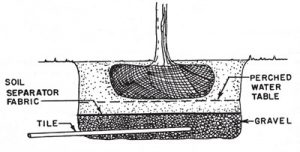
Click image to enlarge.
Figure 2. This drainage system works well for planting in heavy clay soils. The root-ball should be entirely above the upper limit of the perched water table created by the gravel. The gravel layer should be no more than 4 to 6 inches deep. Water will enter the drain tile only when the soil just above is very wet, but as long as the root-ball is above the saturated zone this works well.
How long it takes for roots to grow out into soil depends somewhat on plant species but especially how they were grown. Plants with circling roots, poor nutrition and few white root tips at time of planting may require several weeks to grow a few roots an inch or more. By contrast, plants grown in RootMaker containers and with proper nutrition have grown roots as long as 11 inches in 12 days and in huge numbers. (Figure 4).
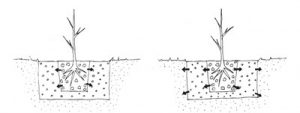
Click image to enlarge.
Figure 3. When the backfill around the plant is soil, water is drawn out of the container mix and into the loosened soil (left). However, as soon as roots grow out into the surrounding loosened soil, moisture is generally available. On the other hand, if the soils around a container-grown plant are amended, water is drawn out of the container mix by the amended soil (since it is finer in texture), and in turn water is drawn out of the amended soil by the unamended soil (right). This leaves the plant “high and dry” because moisture will not move from the moist unamended soil back into the amended soil. When backfill is amended, roots have to grow much farther to reach unamended soil which is a must for long term survival.
Figures courtesy of Dr. Carl E. Whitcomb
- Do not add organic matter such as peat or compost in the planting hole around individual plants. Adding organic matter to soil reduces water retained in that volume of soil and increases the distance roots must grow in order to access unamended soil and water. Consider a 24-inch-diameter planting hole and a plant from a 3-gallon container. If the backfill soil is unamended, roots have access to soil moisture as soon as they grow only an inch or less. By contrast, if the space between the 3-gallon root-ball and side of the 24-inch hole is amended, roots must grow 6 to 7 inches before contacting moisture in unamended soil.
- If you doubt this reality, go back and read the law. Amending soil around individual plants creates a second textural barrier and accelerates drying out of the root-ball and slows establishment of the plant.
- Another complication that routinely occurs with container grown plants installed in the landscape is the rapid percolation of water into the planting hole and root suffocation (Figure 5).
- However, adding peat or other organic matter to the planting hole is only a temporary soil modification anyway. For example, in a study in Oklahoma we used a sandy clay loam soil with 3 percent organic matter. We incorporated 30 percent peat by volume of the planting hole. After 15 months (two growing seasons) the peat had fully decomposed and organic matter level was back to 3 percent. If a plant is to be successful on a landscape site, it must develop roots into the actual soil and the sooner the better.
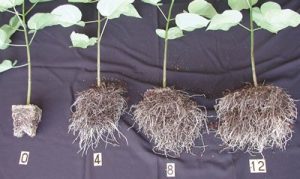
Click image to enlarge.
Figure 4.These catalpa seedlings were grown in 18 cell RootMakerÇ containers. They were transplanted and allowed to develop roots for 12, 8, 4 and 0 days. How the plant was grown, energy in root tissues and extent of root branching play a huge role in how fast roots grow out and establish the plant.
There is an exception:
- Amending soil in raised plant beds, especially for color annuals, may be beneficial. The difference is because the entire rootzone the plant will experience during the growing season is amended, so there is no textural barrier.
- Amending soil in plant beds at ground level may be beneficial if soil internal drainage is good. However, if drainage is marginal and water from rain or irrigation runs across the soil surface and accumulates in the bed, problems of root suffocation and/or disease are likely. Installing drain lines below color beds installed at ground level is generally beneficial.
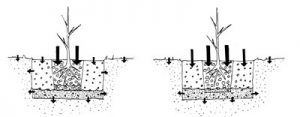
Click image to enlarge.
Figure 5. Water will percolate into a coarse-textured material more quickly than a fine-textured material. When a container grown plant is placed in a heavy soil, water will percolate into the planting hole through the container mix faster than the loosened heavy soil (left). However if soil amendments have been added to the heavy soil, water percolates even faster into the planting hole from the more coarse-textured amended soil (right). This can cause a sufficient “bath tub” effect to restrict or suffocate plant roots.
Water movement in soils is controlled by Darcy’s law of soil physics. Keep this law in mind as it can be helpful in many ways. (For a detailed presentation of this topic including more drawings, photos and solutions to unique planting situations, see Chapters 7 and 9 in Establishment and Maintenance of Landscape Plants II. See www.lacebarkinc.com for ordering.)
Dr. Carl Whitcomb is president of Lacebark, Inc., a private research and plant breeding facility near Stillwater, Okla. Lacebark, Inc. celebrated 25 years in 2010. Prior to creating Lacebark Inc. he was a professor at the University of Florida and Oklahoma State University for 19 years. An inventor and entrepreneur, Dr. Whitcomb holds 30 USA patents and over 30 registered trademarks. He has written five books; four in the field of horticulture and plant science and most recently his autobiography.